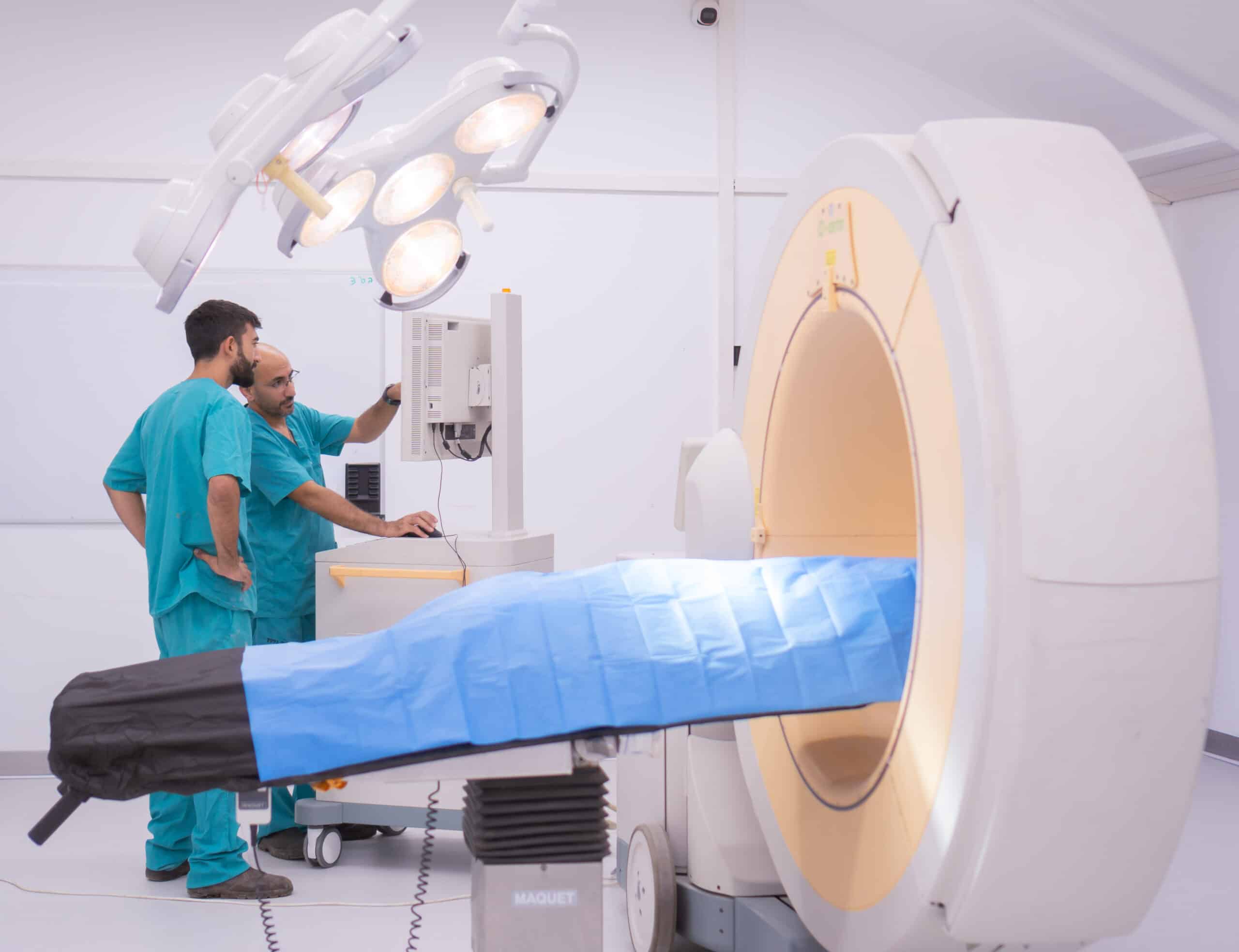BIOTECH FARM is experienced in providing the setups, tools and models for many R&D aspects required for medical devices and pharmaceuticals development. A good animal model enables the research by its similarity to the clinical/ phisiological display and parameters and its resemblance to the human mechanism/ system. A large animal model that is required sometimes as an additional species and many times as the only large enough in vivo model compatible for the device (e.g. stent, stoma) developed, should be at the best fit and handling status. A healthy animal that is at ease and not stressed, an animal that fills safe and happy, is collaborating and its physiological parameters an “in-trial” handling have a great influence on the quality of results. At BIOTECH FARM LTD, our team is primarily trained for keeping the wellbeing and good relationships with the animals. We get close and acquainted. The animals get attention, love and care. We do not get restricted as we get love back.It is important for us.
BIOTECH FARM is commited to the ethics of animal use and husbandry. BIOTECH FARM is a qualified and authoriesed institute being regularly inspected by the governmental authoritis as indicated by law. We provide our costomers with the knowledge required for the setup of the trails based on the Reduction, Refinement and Replacement approaches. Our collaboration with Da-Ta Biotech LTD is aimed for that purpose. When possible or required we suggest the replacement in vitro model or the reduction approach that might give the required result. All trials performed are primarily approved by the ethical committee of the ministry of health.
מודלים של חיות למחקר
חוות ביוטק מתמחה במתן פתרונות, כלים, ומודלים של בע”ח עבור אספקטים רבים במחקר ופיתוח תרופות ומכשור רפואי.
אחד הגורמים ההכרחיים להצלחת המחקר הינו מודל של בעל חיים בעל פרמטרים ומאפיינים הדומים לאלו של האדם ומסיבה זו במחקרים רבים יש צורך בבעל חיים גדול.
אנו בחוות ביוטק מאמינים שמצבם הכללי והפסיכולוגי של בעלי החיים משפיעים על איכות התוצאות ולכן חשוב לנו להקפיד על טיפול אוהב ומסור המבטיח חיה בריאה, לא לחוצה, שמחה ומרגישה נינוחה ובטוחה.
חוות ביוטק מחויבת לכללי האתיקה להחזקת בעלי חיים והינה חברה בעלת הרשאות העומדת בפני ביקורות תכיפות של מוסדות ממשלתיים לפי חוק. כל המחקרים אשר נעשים בחוות ביוטק הינם באישור ועדת האתיקה ומשרד הבריאות.
אנו מספקים ללקוחותינו את הידע ההכרחי להכנות למחקר ובאמצעות שיתוף הפעולה עם חברת דע-תא ביוטק יכולים גם להציע בדיקות מקדימות במודלים תאיים המאפשרים צמצום השימוש במודל חיה תוך מתן כלים מדעיים וניתוחים סטטיסטיים לכל שאלה מחקרית בתחום הביולוגיה והרפואה.
Have you ever contemplated the overlooked contributors in our journey for medical advances? Picture a world where every new treatment was a shot in the dark, risking human lives. That’s where the importance of animal models in preclinical research steps into the spotlight—our sturdy bridge between theory and therapy.
Crafting life-saving drugs isn’t guesswork; it’s grounded on data, often coming from creatures big and small. From mice to monkeys, these animals pave paths toward safety and effectiveness before any human trial takes off.
This journey is not just scientific—it’s also deeply ethical. We’ll dive into Biotech Farm’s tightrope walk over ethical quandaries while peering through cutting-edge lenses that reveal drug impacts like never before.
Sit tight as we unravel how each creature contributes its chapter to our collective health story, guiding us closer to cures that once seemed like mere whispers of hope.
The Role of Animal Models in Drug Development
When we talk about drug development, animal models are the unsung heroes that work behind the scenes. They’re like the stunt doubles for humans, taking on risks to make sure treatments are safe and effective before they reach your medicine cabinet.
Why Animal Models are Indispensable for Preclinical Data
We rely on these furry volunteers because their biological responses can mimic ours, giving us a sneak peek at how new drugs might behave in human patients. Think of them as the crystal ball of biomedicine—animal experiments shed light on potential side effects or toxic reactions. Without this crucial step, clinical trials would be more like stepping into a minefield blindfolded.
An astonishing 92% success rate in predicting human toxicology could only come from such rigorous preclinical studies using specific species tailored to test safety and efficacy. This is where selecting animal models becomes an art form; it’s not just picking any lab rat off the street but choosing one whose genetic makeup plays out our own vulnerabilities against diseases.
Selecting Animal Models for Human Diseases
To address specific health issues accurately, researchers must choose wisely—a common mouse model won’t do when studying complex conditions like Alzheimer’s disease or cystic fibrosis. We need animals with closer physiological similarities to us—think nonhuman primates or genetically engineered rodents crafted specifically to carry human genetic markers of certain illnesses.
This meticulous selection process lets scientists create relevant animal models that can truly mirror our bodies’ response to treatment candidates. It paves the way for advancements even before we start clinical phases—it’s all about getting things right from square one.
Enhancing Drug Administration Techniques through Animal Testing
Finding an effective treatment also means figuring out how best to get it into our system—and once again, animals lend us a hand (or paw). Through trial and error with various delivery methods in preclinical animal studies included guinea pigs and larger beasts alike—we fine-tune surgical techniques and explore technologies develop novel ways drugs enter our bloodstream.
This groundwork ensures that by the time therapies study reaches living breathing people; they’ve been polished smoother than a pebble in a stream making sure each dose packs its intended punch without unexpected hiccups along its journey inside you.
Biotech Farm’s Ethical Approach to Animal Studies
At Biotech Farm, we’re all about marrying innovation with conscience. It’s like peanut butter and jelly—except it’s science and ethics; they just go together. At Biotech Farm, we pledge to not only push the boundaries of medical research but also remain devoted to maintaining ethical practices in our animal studies.
Adhering to Ethical Standards in Animal Experiments
We know that without a solid moral compass, even the most groundbreaking discovery can lose its way. That’s why every test tube and lab coat at Biotech Farm is guided by systematic reviews of ethical practices because nothing says ‘we care’ more than rigorous checks and balances.
A staggering 5 out of 6 drug companies agree: skimping on ethical considerations isn’t an option—and neither do we play fast and loose here. With each study, we ask ourselves tough questions, seeking answers that don’t compromise our furry or feathered colleagues’ welfare.
The Three Rs Principle in Animal Research
Let me paint you a picture: Imagine if every animal experiment was as minimal as possible—that’s Reduction for you; now add some TLC to make sure these creatures are comfy and all not strictly required procedures are avoided —that’d be Refinement; lastly, what if alternatives were always top-of-mind before animals were even considered? Hello Replacement. These aren’t just buzzwords—they’re the pillars holding up our entire operation.
Incorporating this trio into practice isn’t rocket science—but it might as well be given how seriously we take them. Eight out of ten times when faced with a dilemma, referring back to these principles clears things right up—it’s like having an ethical North Star guiding us through uncharted territories of scientific exploration.
Advancements in Large Animal Models for Complex Diseases
When it comes to investigating intricate maladies like Alzheimer’s and cardiac illness, the utilization of large animal models can be a game-changer. They’ve got the heft and complexity that tiny mouse models just can’t match. It’s a bit like comparing a full-scale model airplane to a paper one—they both fly, but only one gives you the real deal.
Guinea Pigs and Heart Disease Research
You might think of guinea pigs as those cute little furballs that squeak for veggies, but they’re heavy hitters in cardiovascular research. With hearts ticking more similarly to ours than mice or rats do, these critters give us golden insights into human heart health. For instance, studies provide evidence that our furry friends’ reaction to cardiac drugs often mirrors what we’d expect in people—a fact not lost on researchers aiming for higher success rates when transitioning from test animal studies to clinical trials.
Gene Editing Technologies in Large Animal Models
Talking about revolutionizing genetic disease study is impossible without tipping our hats off to gene editing—CRISPR/Cas9, I’m looking at you. Now imagine this tech with something bigger than your common lab rat; say hello to genetically engineered nonhuman primates designed meticulously through gene editing technologies. This powerful combo allows scientists not only mimic human conditions closely but also fine-tune treatments before they start clinical trials.
The result? A boost in developing effective treatment options while respecting ethical standards—and all thanks goes partly because someone had the bright idea of asking: “What if?” So whether it’s crafting better therapies for cystic fibrosis or tackling mental health disorders head-on with tailored interventions based on solid animal data—we owe much of this progressiveness to these incredible animals who serve as proxies until science deems them ready for prime time: humans themselves.
Imaging Techniques and Their Role in Animal Model Research
When it comes to peeking inside the complex workings of disease, animal models are our best buddies. But even they need a little help showing us what’s up—or more accurately, what’s inside. Enter advanced imaging techniques like magnetic resonance imaging (MRI) and computed tomography (CT), turning animal research into something akin to a high-def movie.
Magnetic Resonance Imaging in Drug Candidate Assessment
You know how superheroes have x-ray vision? Well, MRI is kind of like that for scientists—minus the cape. This tech lets researchers see beyond fur and bones right down to tiny changes in tissue—a must-have when you’re trying to suss out if a drug candidate could be the next big thing or just another dud. By using MRI, we get real-time info on whether those molecularly targeted therapies are hitting their mark without so much as making an incision.
This isn’t your average photo shoot though; with MRIs we can watch how diseases evolve over time within live animals—talk about reality TV. It gives us this incredible opportunity not only to track treatment effects but also pivot quickly if things aren’t going according to plan.
Computed Tomography for Structural Analysis in Preclinical Trials
If MRIs are superhero sight, then CT scans are clairvoyance—they give structure its moment in the spotlight during preclinical trials. Imagine being able to look at anatomical structures slice by slice—you’d spot issues faster than slicing avocados on Sunday brunch. In drug development especially, understanding where drugs go after administration can mean life-saving advancements down the line.
The beauty of CT scans lies not just in their ability tell us “what” but also “where.” So when we analyze heart tissues or check lung function before starting clinical rounds with human volunteers—the ones who’ve bravely signed up for science—we owe them every bit of assurance that our treatments won’t throw them curveballs because guesswork simply doesn’t cut it here.
Conclusion
Animal models are our sentinels in the fight against disease. They signal what’s safe, what works, and where we need to pivot. Remember this: their role is crucial for those leaps from lab bench to bedside.
They guide us through the thickets of drug development with a torch that lights up potential dangers and triumphs alike. Animal studies at Biotech Farm underscore not just success but also compassion—balancing discovery with dignity.
From guinea pigs to gene editing in larger animals, each step takes us deeper into understanding complex diseases. Imaging technologies like MRI and CT scan deepen these insights even more.
In essence, animal models offer a roadmap—a beacon towards treatments once distant dreams now inching closer to reality because of their contribution.
The importance of animal models in preclinical research can’t be overstated; they’re indispensable allies as we forge ahead toward healing hands reaching out across humanity’s horizon.



